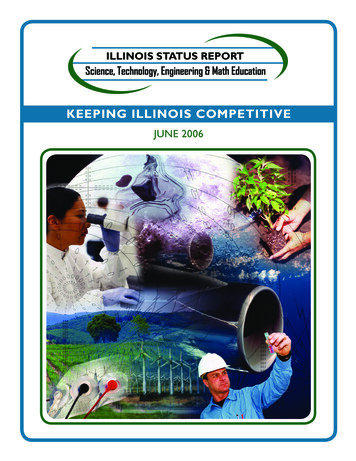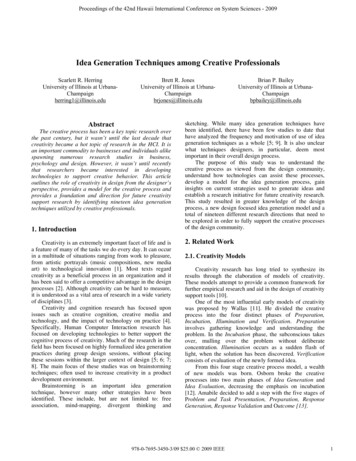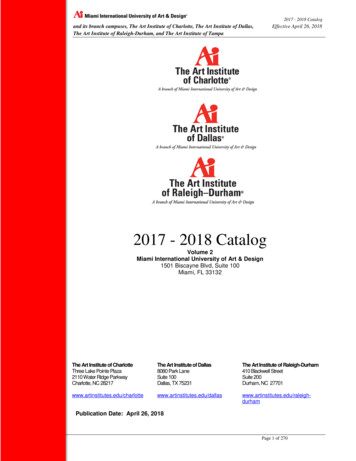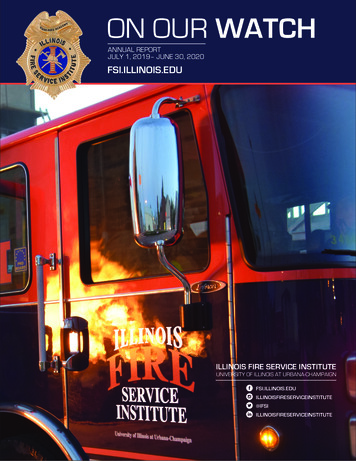
Transcription
The Illinois Institute of Art2013 CatalogEffective May 2013MissionThe Illinois Institute of Art is an institution of higher education offering degree and other academicprograms in the creative and applied arts to a diverse student body. The college promotes studentlearning in a stimulating environment where students can develop their creativity and acquire the skillsand knowledge to pursue their chosen careers.ValuesWe believe in the positive impact of art and design on individuals, industry, and society. Specifically,We believe in encouraging creativity, critical thinking, and independent, life-long learning.We believe in supporting each student, faculty member, and staff member as an active, collaborative participant in theeducational process, respecting diversity, diverse abilities, backgrounds, interests, and points of view.We believe in promoting an environment that encourages community and professional service.We are committed to operating with integrity and developing personal values, ethical practices and social awarenesswithin our students.We believe that faculty and staff development, satisfaction, engagement, and responsibility are essential to productivity,growth, and excellence.We believe in a commitment to student success and continual institutional improvement as well as effective management of change.We believe that competency based outcomes and assessment of student learning lead to excellence in education.We believe an atmosphere of excellence prepares graduates for careers, reflects the needs of the business community,and fosters personal growth and professional success.We are committed to environmental sustainability and its application in our operations, education, and our outreach.PurposeThe purpose of The Illinois Institute of Art is to offer programs of instruction that enable students to develop:Knowledge and skills necessary for entry-level employment and career growth;Intellectual ability, social awareness and leadership skills that will enhance their potential for personal and professionalsuccess; andBroader understanding of ethics, culture, history, science, and the arts.Art Institute of Ohio SBCC School Number 04-01-1698B1 Introduction
The Illinois Institute of ArtLetter from the College PresidentOn behalf of the faculty and staff at The Illinois Institute of Art, I am so pleased that you are considering furthering youreducation at our school. Our students are driven by a passion for their chosen fields and we are proud to provide a careerfocused education that can channel those passions into your life’s work.Whether you yearn to create signature dishes, innovative designs, fashion-forward trends, cutting-edge films, animationsand games or the next advertising campaign that gets everyone talking, our talented faculty is ready to nurture your development and guide you to your goals.At The Illinois Institute of Art our classes are taught by faculty who are both professionals in their fields and experienced,enthusiastic educators. They apply their real-world experience in the classroom so students have the opportunity to receivethe best possible hands-on education they can employ in the workforce.We cultivate our students’ creativity from the day you walk into your first class until the day you walk across the stage inyour cap and gown. Our objective is to give you the tools you need to achieve your goals.We look forward to welcoming you into our school and wish you success in all your endeavors.Sincerely,David RayPresidentThe Illinois Institute of ArtThe Illinois Institute of Art has six locations: the main campus Chicago, Illinois, three branches, and two additional locations:Campus nameType of CampusCityAcronymReferenced in Catalog asThe Illinois Institute of Art ChicagoMainChicago, ILILICChicagoThe Illinois Institute of Art SchaumburgBranchSchaumburg, ILILISSchaumburgThe Illinois Institute of Art Tinley ParkAdditional LocationTinley Park, ILILITPTinley ParkThe Art Institute of Michigan DetroitBranchNovi, MIAIMDDetroitThe Art Institute of Michigan TroyAdditional LocationTroy, MIAIMTTroyThe Art Institute of Ohio CincinnatiBranchCincinnati, OHAIOHCCincinnatiIn the main body of the catalog, the campuses will be referenced by the city name in the right-hand column above.2 Introduction
The Illinois Institute of ArtAccreditationThe Illinois Institute of Art is accredited by The Higher Learning Commission (HLC) and a member of the North Central Association (NCA), 230 South LaSalle Street, Suite 7-500, Chicago, Illinois 60604-1413, 1.800.621.7440, www.ncahlc.org.At the Chicago and Schaumburg campuses, the Interior Design programs leading to the Bachelor of Fine Arts degree areaccredited by the Council for Interior Design Accreditation, http://accredit-id.org/ 206 Grandville Avenue, Suite 350, GrandRapids, MI, 49503. The Cincinnati, Detroit, and Tinley Park programs have not sought this accreditation.The Culinary Arts Associate of Applied Science programs at Chicago and Cincinnati are accredited by The Accrediting Commission of the American Culinary Federation Education Foundation.State LicensingThe three Illinois locations of The Illinois Institute of Art are authorized by the Illinois Board of Higher Education, 431 EastAdams, Second Floor, Springfield, IL 62701, 217-782-2551, www.ibhe.state.il.us/default.htm.The three Illinois locations of The Illinois Institute of Art have Certificates of Approval to Operate Issued by the Illinois StateSuperintendent of Education, 100 North First Street, Springfield, Illinois 62777.The Art Institute of Ohio–Cincinnati holds a provisional Certificate of Authorization for its academic degree programs byThe Ohio Board of Regents, 30 East Broad Street, Suite 2481, Columbus, OH 43215. The provisional accreditation expires onDecember 31, 2012. (The Art Institute of Ohio - Cincinnati SBCC school number is 04-01-1698B.)The Art Institute of Ohio–Cincinnati is licensed by the Ohio State Board of Career Colleges and Schools, 35 E. Gay Street,Columbus, OH 43266-0591, 614-466- 2752.The Art Institute of Ohio–Cincinnati is regulated by Indiana Commission on Proprietary Education (302 W. WashingtonStreet, Room E201, Indianapolis, IN 46204-27671), telephone 317-232-1320 in state, TOLL FREE 800-227-5695The Art Institute of Michigan is licensed under the laws of the Michigan Department of Energy, Labor & Economic Growth.Consumer InformationYou can find important consumer information at www.artinstitutes.edu/chicago, www.artinstitutes.edu/cincinnati, www.artinstitutes.edu/detroit, www.artinstitutes.edu/schaumburg, and www.artinstitutes.edu/tinley-park. For each campus, information about school security policies, crime statistics, crime logs, fire safety policies, fire statistics, and fire log is found byclicking on the Student Consumer Information link, then the Student Services Revealed link, and then the crime report link.See aiprograms.info for program duration, tuition, fees, and other costs, median debt, federal salary data, alumni success,and other important info.For information about online offerings through The Art Institute of Pittsburgh - Online Division, see www.aionline.com.3 Introduction
The Illinois Institute of ArtThe Illinois Institute of ArtThe Illinois Institute of Art is part of the exciting history of Chicago. Founded in 1916 as The Commercial Arts School, TheIllinois Institute of Art was one of the first applied art and design colleges in the United States. The college school was widelyknown in the 1930s as Ray-Vogue School, with professional programs in art, design and fashion. The school was renamedRay College of Design in 1981, and joined The Art Institutes system of schools in 1995. The Illinois Institute of Art offersBachelor of Fine Arts, Bachelor of Arts, Bachelor of Science, Bachelor of Applied Science, and Associate of Applied Sciencedegrees, as well as diploma programs.Faculty and staff of The Illinois Institute of Art are dedicated to providing students the tools and knowledge they need topursue their goals. When students arrive at The Illinois Institute of Art, they bring their creative drive; their “mind to imagine.” Dedicated faculty with industry experience offer students “the skills to create.” Whichever creative program studentschoose, The Illinois Institute of Art strives to provide the knowledge necessary to enter that field. Upon graduation, ourdedicated Career Services staff work with each eligible student to assist in the employment search. Students’ personal driveand ambition complete the mix for academic and professional growth.Locations and FacilitiesChicago CampusLocated in the heart of downtown Chicago, the Chicago campus of The Illinois Institute of Art has two facilities located incentral areas just eight blocks apart. One facility is at the Mart Center, connected by skywalk to the world-famous Merchandise Mart. Students attend classes in the heart of Chicago’s design industry center. The Merchandise Mart is the world’slargest commercial building and wholesale design center, which houses hundreds of elite design showrooms. The campuslocation provides students with many opportunities in the design industry through its proximity to design businesses at theMart Center and the national trade shows and regional markets held throughout the year.The second facility is the Loop campus location at 180 North Wabash, located in the heart of Chicago’s Loop. The locationprovides easy access to the theater district, “State Street, that great street” shopping on the Magnificent Mile of MichiganAvenue, and Millennium Park. The BackStage Bistro, housed within the Loop location, is the Chicago campus’s studentoperated restaurant. The restaurant features glass walls through which patrons can see into the kitchens where culinary artsstudents prepare and serve food in the restaurant.Schaumburg CampusThe Schaumburg campus is located in the Village of Schaumburg, 30 miles northwest of Chicago. Whether it’s for a quickhalf-day jaunt to the lakefront or for a weekend away, Schaumburg residents have easy access to all of the attractions ofdowntown Chicago. Schaumburg has grown from a sleepy farm community to become one of the foremost Edge Cities inthe United States. It boasts a thriving professional community and there are more businesses in the Schaumburg area thanin downtown Philadelphia, Washington, D.C., Dallas or Portland. These businesses combine to contribute more than 190,000jobs to the Schaumburg region.Cincinnati CampusThe Cincinnati Campus, The Art Institute of Ohio–Cincinnati, was founded in 2004 and is located in the thriving northeastCincinnati suburbs, just 20 minutes from downtown Cincinnati. Known as the Queen City, Cincinnati features great natural beauty with steep hills, wooded suburbs, a picturesque downtown riverfront, and four definite seasons. Awarded byFortune magazine as one of the top ten places to live and work, the greater Cincinnati area is a three-state, 15-county regionthat offers world-class assets in arts and culture, amusements, hospitality, sports and recreation. Cincinnati features all theamenities of a large, bustling metropolis while maintaining a friendly, small town atmosphere - a unique balancing act of4 Introduction
The Illinois Institute of Artextraordinary contrasts - but one that makes the region a remarkably flexible location filled with a wealth of opportunitiesand options.Michigan campusesThe first Michigan campus, in the city of Novi, Michigan, was founded in 2007 and is located twenty five minutes northwestof downtown Detroit at the convergence of three major highways: I-696, I-275, and I-96. It is nestled among trees and pondsin a picturesque suburban setting with easy access to the greater metropolitan Detroit area. Metro Detroit has blue collarroots in manufacturing with a paralleling cosmopolitan rebirth occurring. Students can easily explore local history and experience a vast array of cultures and creativity in the galleries, theaters and music venues of downtown Detroit. The campusesare proud of the local cultural diversity boasting that more than 35 businesses based in Japan and at least 14 businessesbased in Germany call southeast Michigan “home” in the United States. Multicultural access, a creative community, and acommitment to diversity are all characteristics of our growing creative campuses.Novi’s unique outdoor sculpture garden is designed to promote an appreciation of form and design across a broad range ofmedia for our students. A view of the many local artist sculptures can be seen from the campus’s student run restaurantcalled The Great Lakes Bistro. Similar to fashion, graphic and interior design projects hanging in the campus galleries, TheGreat Lakes Bistro is the place to see aspiring chefs prepare meals and to sample a taste of our culinary students’ hard workin our instructional kitchens. The Michigan campus in Troy was founded in 2011. The faculty, staff and student body are asdiverse as the local population. The Art Institute of Michigan is a destination school for those seeking an applied educationalapproach to an education in Fashion, Design, Media or the Culinary Arts in southeast Michigan.Tinley Park CampusThe Tinley Park campus is located in the Village of Tinley Park, just a short drive or train ride south from Chicago, which isone of the most rapidly growing communities in this Midwest metropolitan area. A walk along Oak Park Avenue, the village’smain thoroughfare, takes residents by restaurants, shops, and businesses that make up the renovated historic district. Oneof the village’s most popular events is the Benches on the Avenue public art project in which handcrafted wooden seatingcreated by local artists is placed along Oak Park Avenue for the summer. Students can hop on the train to get to downtownChicago or access interstate highways as well as three international airports – Midway, O’Hare, and Gary/Chicago. Recognized by BusinessWeek magazine in 2009 as the best place to raise a family in America, Tinley Park is a mix of the traditionaland contemporary for students seeking an education in the creative and applied arts.5 Introduction
Academic AffairsAcademic Affairs MissionThe mission of the Academic Affairs Department is to prepare undergraduate students for entry-level careers in applied artsand to provide a learning environment in which they acquire the foundational skills and broad contextual understandingthat will help them have meaningful, rewarding careers.Graduates of The Illinois Institute of Art should: Have written and oral skills that enable them to communicate effectively with prospective employers, colleagues,clients, and the general public. They will be able to formulate a message in more than one medium. Possess creative design and problem-solving skills that result in imaginative, innovative, professional-level solutionswithin parameters such as deadlines, audience or customer expectation and budget. Have a thorough understanding of the field they plan to enter, including foundational elements and principles, technical skills, and terminology. Have an understanding of connections between their lives and the broader world in which they will perform theirprofession, applying observation, research, reasoning, creativity, and analysis to global issues through the lens of thehumanities, arts, natural sciences and social sciences. Have developed themselves professionally, attaining a professional demeanor that matches industry standards, anunderstanding of business practices, and an understanding of continuous career development.General EducationMission and PhilosophyThe General Education department, in accord with the overall mission of The Illinois Institute of Art, is committed to providing students the skills, knowledge and critical thinking ability needed for personal and professional development within alearner-centered, competency-based curriculum that fosters academic and intellectual excellence. The General Educationrequirements are designed to develop and increase students’ ability to understand people, cultures, and scientific, philosophical and artistic discoveries with the goal of developing graduates ready for personal and career challenges.General Education is designed to foster the ability to think independently, use reasoned analysis, understand the methods ofscientific inquiry, communicate effectively, explore human behavior and culture, develop an ethical value structure, respectdiversity within a global society and to appreciate and inspire creative endeavors. All areas of specialization require thesegeneral abilities. The breadth and rigor of the general education curriculum complements the academic programs and is designed to foster the integration of knowledge across disciplines. The academic categories comprising the general educationcurriculum are communications, math and computer science, physical and life sciences, humanities and fine arts, and socialand behavioral sciences.Desired Student Outcomes:General Education is an integral component of every academic program at The Illinois Institute of Art. It offers students abroad knowledge base, competencies, and perspectives necessary for a productive personal and professional life by advancing the following outcomes:Reasoning: to understand forms of logic or ways of thinking.Problem Solving: to use reason in a specific context in order to answer a specific question. Problem solving may involve oneor more of the following: defining terms and tasks, organizing and verifying solutions, explaining or justifying a position.Communication: to construct and exchange messages through verbal and non-verbal symbolic systems such as reading,writing, speaking, listening, and gesture.Connections: to identify or recognize relationships within and across discipline-specific forms of thought.Representation: to formulate a message through the use of alternative mediums to express or present facts, thoughts,ideas, concepts, arguments, values, perspectives, or opinions.6 Academic Affairs
Academic AffairsResearch: to investigate a topic systematically, cogently arguing a well-formed hypothesis, and amply citing sources of informationArt Foundations CoursesFoundations courses teach students visual communication skills related to most of the academic programs.MissionThe primary purpose of the Foundations program is to provide all students in one of the design programs with a rigorous artand design foundation, enabling them to advance in their respective area of study. These competencies are accomplished ina studio environment through learner-centered instruction delivered by qualified faculty to students who are capable of andcommitted to an active role in learning.Desired Student Outcomes:1. Students develop hand and drawing skills.2. Students develop the ability to use basic art materials.3. Students apply the elements and principles of design to art compositions.4. Students create work that meets pre-determined parameters.5. Students demonstrate a logical approach to problem solving.6. Students generate original ideas from outside sources.7. Students use art and design vocabulary to analyze and critique Foundations artwork, both their own and peer students’.Transitional StudiesTransitional Studies is designed to prepare students for coursework at The Illinois Institute of Art. Transitional Studies facultyand staff are committed to increasing students’ knowledge of basic skills in math, writing, and technology with the goal ofpreparing them for the challenge of academic life as they become independent learners.The Illinois Institute of Art assesses the reading, writing, math and computer skills of entering students to determine if theycould benefit from additional assistance. Placement is determined based on transfer credit, ACT or SAT test scores, ACCUPLACER (an online placement exam produced by the College Board), and sometimes ASSET (a placement exam producedby ACT).Transitional courses are coordinated closely with each campus’s learning center to provide tutoring in math, English andother subjects, and with the Student Affairs staff to provide academic advising and counseling. Transitional Studies coursesare non-credit courses to be taken within the first year of study.Desired Student outcomes:Academic Development: Students develop skills necessary for their academic and social integration into the academic environment.Written Communication: an ability to develop essays and paragraphs that are logically structured.Problem-Solving: basic problem-solving skills that directly relate to their fields of study.Computer Literacy: basic computer skills for use in their field of study and general education classes.7 Academic Affairs
Degree RequirementsAssessment ProgramAs an institution of higher education The Illinois Institute of Art is committed to excellence in teaching and learning. Reflecting that commitment, The Illinois Institute of Art has a formal, ongoing assessment of student learning and achievement.The Illinois Institute of Art collects and analyzes data on the nature and extent of student learning and uses that analysis toenhance both teaching and learning. Under the guidance and direction of the Deans of Academic Affairs and the Directorsof Assessment, assessment involves the entire school community—students, faculty, staff, and administration—in a coordinated effort to use the assessment of learning as a cornerstone for curriculum development and institutional improvement.Degree RequirementsRequirements for Bachelor of Arts, Bachelor of Science, or Bachelor of Fine Arts DegreesTo receive a Bachelor of Arts, Bachelor of Science, or Bachelor of Fine Arts degree, students must complete a minimum of180 quarter-credits, including 60 quarter- credits of general education. Each General Education course is 4 credits, exceptfor GEN092 Foundation Portfolio which is 1 credit. Specified courses may be required for specific programs; adjustments indistribution within the 60 credits may be made to reflect specific program needs, as noted in departmental requirements.Unless otherwise indicated requirements apply to all locations.General Education Requirements1. Communication (3 courses)GEN101 English IGEN102 English IIGEN105 Effective Speaking2. Math and Computer Science (2-3 courses)GEN150 Mathematical Concepts and Connections1 additional mathematics courses or 4 credit-hours: GEN153-157, GEN250-258 (at Schaumburg students must choose fromGEN250-258 only)At Chicago, Tinley Park, Detroit, and Troy, 1 computer course or 4 credit-hours: GEN 107 (for B.S. in Hospitality) or GEN1093. Physics and Life Sciences (3 courses)1 life science course or 4 credit-hours: GEN260-GEN266, GEN2761 additional 200-level science course or 4 credit-hours: GEN260-GEN2861 300-level science course or 4 credit-hours: GEN360-GEN3824. Humanities and Fine Arts (3 courses)1 fine arts course or 4 credit-hours: GEN205-GEN2121 additional 200-level fine arts/humanities course or 4 credit-hours: GEN205-GEN2331 300-level fine arts/humanities course or 4 credit-hours: GEN310-GEN3355. Social Sciences (2-3 courses)1 200-level course or 4 credit hours: GEN241-GEN248At Schaumburg and Cincinnati, 1 additional 200-level course or 4 credit-hours: GEN241-GEN2481 300-level course or 4 credit hours: GEN340-GEN3456. General Education CapstoneGEN399In addition, Foundation Portfolio, GEN092, is required at Chicago, Tinley Park, and Cincinnati of all entering students withfewer than 24 hours of transfer credit.8 Academic Affairs
Degree RequirementsRequirements for Bachelor of Applied Science DegreeTo receive a Bachelor of Applied Science degree, students must complete a minimum of 180 quarter-credits, including 56quarter-credits of general education.General Education Requirements1. Communication (3 courses.)GEN101 English IGEN102 English IIGEN105 Effective Speaking2. Math and Computer Science (2 courses)GEN150 Mathematical Concepts and Connections1 computer course or 4 credit-hours (Chicago, Detroit, Cincinnati)1 additional mathematics course at Schaumburg3. Physics and Life Sciences (2 courses)1 chemistry course or 4 credit-hours: GEN2731 additional 200-level science course or 4 credit-hours4. Humanities and Fine courses (4 courses)2 Spanish language courses or 8 credit hours: GEN201 and GEN2021 additional 200-level fine arts/humanities course or 4 credit-hours: GEN205-GEN2331 300-level fine arts/humanities course or 4 credit hours: GEN310-GEN3355. Social Sciences (2 courses)1 economics course or 4 credit-hours1 200-level course or 4 credit-hours6. General Education CapstoneGEN399In addition, Foundation Portfolio, GEN092, is required at Chicago, Tinley Park, and Cincinnati of all entering students withfewer than 24 hours of transfer credit.Requirements for Associate of Applied Science DegreeTo receive an Associate of Applied Science Degree, students must complete a minimum of 90 quarter-credits with 24quarter-credits in general education.General Education Requirements1. Communication (2 courses.)GEN101 English IGEN105 Effective Speaking2. Math and Computer Science (1 course)GEN150 Mathematical Concepts and Connections3. Physical and Life Sciences (1 course)1 course or 4 hours: GEN260-GEN2864. Humanities and Fine Arts (1 course)1 course or 4 hours: GEN201-GEN2339 Academic Affairs
Degree Requirements5. Social Sciences (1 course)1 course or 4 hours: GEN241-GEN248In addition, Foundation Portfolio, GEN092, is required at Chicago, Tinley Park, Cincinnati for all entering students with fewerthan 24 hours of transfer credit.Diploma RequirementsRequirements for DiplomasTo receive a diploma, students must complete between 36 and 55 quarter-credits, depending on the program. Unless otherwise indicated requirements apply to all locations.10 Academic Affairs
Degree and Diploma ProgramsDegree ProgramsCulinaryCulinary Management, B.A.S, Offered at Chicago, Cincinnati, Detroit, Schaumburg (degree completion only)Culinary Arts, A.A.S., offered at Chicago, Cincinnati, DetroitHospitality Management, B.S., A.A.S., offered at Chicago, SchaumburgDesignAdvertising, B.A., offered at Chicago, Cincinnati, Schaumburg, Tinley ParkGraphic Design, B.F.A., A.A.S., all campusesIllustration & Design, B.F.A., offered at Chicago, SchaumburgInterior Design, B.F.A., all campuses; A.A.S., offered at Cincinnati, DetroitFashionFashion Design, B.F.A., offered at Chicago, SchaumburgFashion Marketing & Management, B.A., all campusesFashion Merchandising, A.A.S., all campusesMedia ArtsAudio Production, B.S., offered at Chicago, Detroit, SchaumburgDigital Filmmaking & Video Production, B.F.A., Chicago, Cincinnati, Schaumburg, ; the A.A.S. associated with this program,Video Production, is offered at CincinnatiDigital Photography, B.F.A., all campusesGame Art & Design, B.F.A., offered at Chicago, SchaumburgMedia Arts & Animation, B.F.A., all campusesVisual Effects & Motion Graphics, B.F.A., offered at SchaumburgWeb Design & Interactive Media, B.F.A., offered at Cincinnati, Detroit, Schaumburg, Troy; A.A.S., offered at Cincinnati,Detroit, Schaumburg, TroyDiploma ProgramsBaking & Pastry, Diploma, offered at Chicago, Cincinnati, DetroitCulinary Arts, Diploma, offered at Chicago, Cincinnati, DetroitDigital Design, Diploma, offered at SchaumburgResidential Planning, Diploma, offered at SchaumburgFashion Retailing, Diploma, offered at Chicago, Cincinnati, Detroit, Schaumburg, Tinley Park, TroyDigital Image Management, Diploma, offered at Chicago, Cincinnati, Detroit, Schaumburg, Tinley Park, TroyWeb Design & Development, Diploma, offered at Cincinnati, Detroit, Schaumburg, Tinley Park, TroyWeb Design & Interactive Communications, Diploma, offered at Cincinnati, Detroit, Schaumburg, Tinley Park, TroyIn the program pages which follow, for those courses where specific co/prerequisite exceptions are stated for individuallocations, exceptions will only apply for the respective locations.11 Academic Affairs
CULINARYCULINARY MANAGEMENT, Bachelor of Applied Science DegreeOffered at Chicago, Detroit, Cincinnati. Offered at Schaumburg as a degree completion program forstudents with an appropriate associate degree from another college.Program MissionThe mission of the Bachelor Degree in Culinary Management is to provide a market-driven, competency-based educationthat integrates academics and hands-on learning and instruction. The practical culinary skills and management courses inthis program will prepare students for entry-level management positions in the food service industry as well as provide afoundation for the graduate to advance in the culinary management field.Desired Student Outcomes1. Culinary theory and terminology: Graduates will display proficiency of various culinary procedures and applications, willbe able to define and apply appropriate culinary terminology.2. Cooking: Graduates will be able to produce products according to desired outcomes based on desired quality standards.3. Cuisines: Graduates will be able to identify elements of various cuisines.4. Finance: Graduates will understand cost factors of food production and be able to analyze financial statements for foodservice operations, and be able to effect change; graduates will understand financial elements at an advanced level, including budgets, cost control, property management issues and will be able to use spreadsheets and other software.5. Professional awareness: Graduates will have an understanding of culinary careers and the structure and culture of theculinary field; they will understand professional and ethical behavior in the workplace.6. Communication: Graduates will demonstrate effective interpersonal relations in a culinary team. In a commercial settingthey will be able to read customer needs and create a clear menu; graduates will have at least basic fluency in Spanish aswell as English; oral communication skills; report-writing skills; and managerial skills.7. Prob
The Illinois Institute of Art has six locations: the main campus Chicago, Illinois, three branches, and two additional locations: Campus name Type of Campus City Acronym Referenced in Catalog as The Illinois Institute of Art Chicago Main Chicago, IL ILIC Chicago The Illinois Institute of Art Schaumburg Branch Schaumburg, IL ILIS Schaumburg










